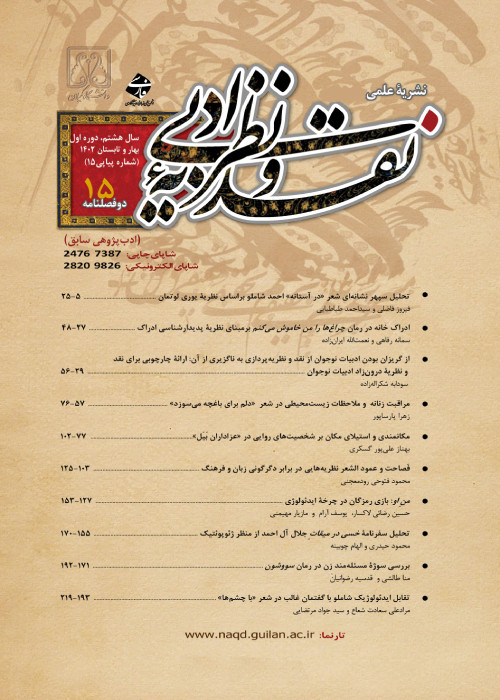The Crisis of Character Development in Goli Taraghi’s “The Pear Tree”
Author(s):
Article Type:
Research/Original Article (دارای رتبه معتبر)
Abstract:
In “The Pear Tree” from the collection Elsewhere (2000), Goli Targhi presents a first-person narrative about a writer and university professor who struggles to overcome scientific stagnation, face the past, and reassess his achievements and losses. In the background of these struggles, there is the Damavand garden and the pear tree which symbolize the flourishing and static contradiction within the narrator-character. The present article reads the narrative in terms of Eric Erikson’s psychosocial theory to analyze its crises of character development. The significance of this study is in explaining the roots of the narrator’s motivations and feelings which can lead to a better understanding of the complexity of the role of social and psychological concerns in overcoming his personality crises. Since the narrator is in his late sixties, the range that can be considered as the end of middle age and the beginning of the period after it, the 7th and 8th stages of Erikson’s development are used in the analysis of his personality. These stages are characterized by the binaries of “generativity vs. stagnation” and “ego integrity vs. despair” and can lead to the acquisition of the moral virtues of “care” and “wisdom.” This study concludes that while the narrator-character succeeds in passing through the 7th stage and acquiring the virtue of care, he is somewhat unsuccessful in the struggle for the acquisition of ego integrity and wisdom, although at the end of the story he evidently tries to achieve them. Extended Abstract1.IntroductionPsychological mechanisms, such as projection, association and stream of consciousness, play an important role in Goli Taraghi’s “The Pear Tree,” which revolves around the emotions and motivations of the protagonist. The present study draws on Erik Erikson’s psychosocial theory to analyze the middle-age concerns of the protagonist from a psychoanalytical point of view in order to arrive at a better understanding of the protagonist. 2.Theoretical FrameworkErik Erikson’s psychosocial theory has been adopted as the theoretical framework of the present study. The focus of the study is on the 7th and 8th characteristics of Erikson theory of development, which cover middle age and later. This period is characterized by “generativity vs. stagnation” and “integrity vs. despair.” 3.MethodologyIn the present article, Erik Erikson’s psychosocial theory has been used to analyze the concerns connected with a specific period of the protagonist of Goli Taraghi’s “The Pear Tree.” The characteristics of the 7th and 8th stages of Erikson’s theory have been focused on in the study of this text. 4.Discussion and AnalysisThe pear tree symbolizes ‘generativity vs. stagnation’. Numerous references to this tree make the narrator remember his sterility. Throughout the story, the protagonist struggles in his mind with his sterility and middle-age crisis, with the outside world being symbolized through the garden. He finds himself destined to fight the stagnation and achieve generativity through writing, which in a way makes him isolated in the story. He shows signs of the emotional crisis associated with the end of the middle age, which according to Erikson is the 7th stage of development. His inability to write can symbolize crises associated with the 7th and 8th stages of development. 5.Conclusion“The Pear Tree” is packed with descriptions of the psychosocial condition of the protagonist. The protagonist experience two crises throughout the story. The first half of the story mostly deals with ‘generativity vs. stagnation’, while the second part revolves around ‘integrity vs. despair’. The protagonist successfully overcomes the ‘generativity vs. stagnation’. The virtue of ‘wisdom’ can be gained for him after encountering the ‘integrity vs. despair’ binary opposition. Select BibliographyErikson, E. H. 1968. Identity: Youth and Crisis. New York and London: W. W. Norton and Company.Erikson, E. H. 1977. Childhood and Society. London: Paladin Books.Fani, K. and Dehbashi, A. 1380 [2001]. “Naqd-e Adabi: Goftegou ba Goli-e Taraghi.” Bokhara 19: 30-54.Hammak, Ph. 2015. “Theoretical Foundations of Identity.” In: McLean K. C. and M. Syed (eds.). The Oxford Handbook of Identity Development. Oxford: Oxford University Press. pp. 11-30.Lachman, M. E. and Bertrand, R. M. 2001. “Personality and the Self in Midlife.” In: Lachman, M. E. (ed.). Handbook of Midlife Development. New York: John Wiley and Sons. pp. 279-309.Lachman, M. E. and James, J. B. 1997. “Charting the Course of Midlife Development: An Overview.” In: M. E. Lachman and J. B. James (eds.). Multiple Paths of Midlife Development. Chicago and London: University of Chicago Press. pp. 1-17.Taraghi, G. 1379 [2000]. Jayi Digar. Tehran: Niloufar.
Keywords:
Language:
Persian
Published:
Literary Theory and Criticism, Volume:7 Issue: 1, 2022
Pages:
183 to 206
magiran.com/p2523251
دانلود و مطالعه متن این مقاله با یکی از روشهای زیر امکان پذیر است:
اشتراک شخصی
با عضویت و پرداخت آنلاین حق اشتراک یکساله به مبلغ 1,390,000ريال میتوانید 70 عنوان مطلب دانلود کنید!
اشتراک سازمانی
به کتابخانه دانشگاه یا محل کار خود پیشنهاد کنید تا اشتراک سازمانی این پایگاه را برای دسترسی نامحدود همه کاربران به متن مطالب تهیه نمایند!
توجه!
- حق عضویت دریافتی صرف حمایت از نشریات عضو و نگهداری، تکمیل و توسعه مگیران میشود.
- پرداخت حق اشتراک و دانلود مقالات اجازه بازنشر آن در سایر رسانههای چاپی و دیجیتال را به کاربر نمیدهد.
In order to view content subscription is required
Personal subscription
Subscribe magiran.com for 70 € euros via PayPal and download 70 articles during a year.
Organization subscription
Please contact us to subscribe your university or library for unlimited access!


